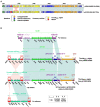First report of coexistence of bla KPC-2-, bla NDM-1- and mcr-9-carrying plasmids in a clinical carbapenem-resistant Enterobacter hormaechei isolate
- PMID: 37032905
- PMCID: PMC10076803
- DOI: 10.3389/fmicb.2023.1153366
First report of coexistence of bla KPC-2-, bla NDM-1- and mcr-9-carrying plasmids in a clinical carbapenem-resistant Enterobacter hormaechei isolate
Abstract
Introduction: Colistin is regarded as one of the last-resort antibiotics against severe infections caused by carbapenem-resistant Enterobacteriaceae. Strains with cooccurrence of mcr-9 and carbapenemase genes are of particular concern. This study aimed to investigate the genetic characteristics of a bla KPC-2-carrying plasmid, bla NDM-1-carrying plasmid and mcr-9-carrying plasmid coexisting in a carbapenem-resistant Enterobacter hormaechei isolate.
Methods: E. hormaechei strain E1532 was subjected to whole-genome sequencing, and the complete nucleotide sequences of three resistance plasmids identified in the strain were compared with related plasmid sequences. The resistance phenotypes mediated by these plasmids were analyzed by plasmid transfer, carbapenemase activity and antimicrobial susceptibility testing.
Results: Whole-genome sequencing revealed that strain E1532 carries three different resistance plasmids, pE1532-KPC, pE1532-NDM and pE1532-MCR. pE1532-KPC harboring bla KPC-2 and pE1532-NDM harboring bla NDM-1 are highly identical to the IncR plasmid pHN84KPC and IncX3 plasmid pNDM-HN380, respectively. The mcr-9-carrying plasmid pE1532-MCR possesses a backbone highly similar to that of the IncHI2 plasmids R478 and p505108-MDR, though their accessory modules differ. These three coexisting plasmids carry a large number of resistance genes and contribute to high resistance to almost all antibiotics tested, except for amikacin, trimethoprim/sulfamethoxazole, tigecycline and polymyxin B. Most of the plasmid-mediated resistance genes are located in or flanked by various mobile genetic elements, facilitating horizontal transfer of antibiotic resistance genes.
Discussion: This is the first report of a single E. hormaechei isolate with coexistence of three resistance plasmids carrying mcr-9 and the two most common carbapenemase genes, bla KPC-2 and bla NDM-1. The prevalence and genetic features of these coexisting plasmids should be monitored to facilitate the establishment of effective strategies to control their further spread.
Keywords: Enterobacter hormaechei; carbapenemase genes; mcr-9; multidrug resistance; plasmid.
Copyright © 2023 Yuan, Xia, Xiong, Xie, Lv, Sun and Feng.
Conflict of interest statement
The authors declare that the research was conducted in the absence of any commercial or financial relationships that could be construed as a potential conflict of interest.
Figures





Similar articles
-
Co-infections of two carbapenemase-producing Enterobacter hormaechei clinical strains isolated from the same diabetes individual in China.J Med Microbiol. 2021 Mar;70(3). doi: 10.1099/jmm.0.001316. Epub 2021 Jan 29. J Med Microbiol. 2021. PMID: 33528353
-
First Report of Coexistence of bla SFO-1 and bla NDM-1 β-Lactamase Genes as Well as Colistin Resistance Gene mcr-9 in a Transferrable Plasmid of a Clinical Isolate of Enterobacter hormaechei.Front Microbiol. 2021 Jun 18;12:676113. doi: 10.3389/fmicb.2021.676113. eCollection 2021. Front Microbiol. 2021. PMID: 34220761 Free PMC article.
-
Epidemiological Characterization of Colistin and Carbapenem Resistant Enterobacteriaceae in a Tertiary: A Hospital from Anhui Province.Infect Drug Resist. 2021 Apr 6;14:1325-1333. doi: 10.2147/IDR.S303739. eCollection 2021. Infect Drug Resist. 2021. PMID: 33854345 Free PMC article.
-
One Health at Risk: Plasmid-Mediated Spread of mcr-1 Across Clinical, Agricultural, and Environmental Ecosystems.Antibiotics (Basel). 2025 May 15;14(5):506. doi: 10.3390/antibiotics14050506. Antibiotics (Basel). 2025. PMID: 40426572 Free PMC article. Review.
-
Carbapenem Resistance in Gram-Negative Bacteria: The Not-So-Little Problem in the Little Red Dot.Microorganisms. 2016 Feb 16;4(1):13. doi: 10.3390/microorganisms4010013. Microorganisms. 2016. PMID: 27681907 Free PMC article. Review.
Cited by
-
Situation Report on mcr-Carrying Colistin-Resistant Clones of Enterobacterales: A Global Update Through Human-Animal-Environment Interfaces.Curr Microbiol. 2023 Nov 21;81(1):12. doi: 10.1007/s00284-023-03521-8. Curr Microbiol. 2023. PMID: 37989899 Review.
-
Whole-genome sequencing of clinical isolates of Citrobacter Europaeus in China carrying blaOXA-48 and blaNDM-1.Ann Clin Microbiol Antimicrob. 2024 Apr 29;23(1):38. doi: 10.1186/s12941-024-00699-y. Ann Clin Microbiol Antimicrob. 2024. PMID: 38685062 Free PMC article.
-
First report of a carbapenem-resistant Serratia sarumanii clinical strain co-harboring bla KPC-2 and bla NDM-1 genes in China.Curr Res Microb Sci. 2025 May 26;9:100411. doi: 10.1016/j.crmicr.2025.100411. eCollection 2025. Curr Res Microb Sci. 2025. PMID: 40521375 Free PMC article.
-
First report of coexistence of blaKPC-2 and blaNDM-1 in carbapenem-resistant clinical isolates of Klebsiella aerogenes in Brazil.Front Microbiol. 2024 Feb 14;15:1352851. doi: 10.3389/fmicb.2024.1352851. eCollection 2024. Front Microbiol. 2024. PMID: 38426065 Free PMC article.
-
Carbapenem Resistance in Acinetobacter calcoaceticus-baumannii Complex Isolates From Kathmandu Model Hospital, Nepal, Is Attributed to the Presence of bla OXA-23-like and bla NDM-1 Genes.Biomed Res Int. 2024 Aug 12;2024:8842625. doi: 10.1155/2024/8842625. eCollection 2024. Biomed Res Int. 2024. PMID: 39161641 Free PMC article.
References
-
- Borowiak M., Baumann B., Fischer J., Thomas K., Deneke C., Hammerl J. A., et al. . (2020). Development of a novel mcr-6 to mcr-9 multiplex PCR and assessment of mcr-1 to mcr-9 occurrence in Colistin-resistant Salmonella enterica isolates from environment, feed, animals and food (2011-2018) in Germany. Front. Microbiol. 11:80. doi: 10.3389/fmicb.2020.00080, PMID: - DOI - PMC - PubMed
LinkOut - more resources
Full Text Sources

